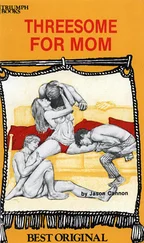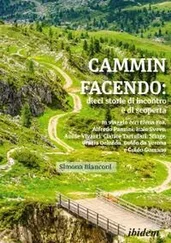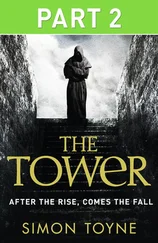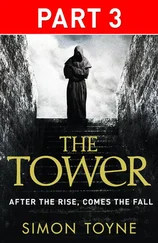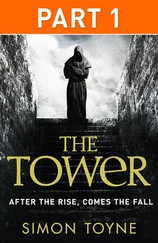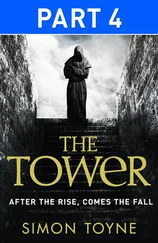Simon Foster - CHINA's Three Gorges & Xi'an
Здесь есть возможность читать онлайн «Simon Foster - CHINA's Three Gorges & Xi'an» весь текст электронной книги совершенно бесплатно (целиком полную версию без сокращений). В некоторых случаях можно слушать аудио, скачать через торрент в формате fb2 и присутствует краткое содержание. Год выпуска: 2010, Издательство: Hunter, Жанр: Старинная литература, на английском языке. Описание произведения, (предисловие) а так же отзывы посетителей доступны на портале библиотеки ЛибКат.
- Название:CHINA's Three Gorges & Xi'an
- Автор:
- Издательство:Hunter
- Жанр:
- Год:2010
- ISBN:нет данных
- Рейтинг книги:4 / 5. Голосов: 1
-
Избранное:Добавить в избранное
- Отзывы:
-
Ваша оценка:
- 80
- 1
- 2
- 3
- 4
- 5
CHINA's Three Gorges & Xi'an: краткое содержание, описание и аннотация
Предлагаем к чтению аннотацию, описание, краткое содержание или предисловие (зависит от того, что написал сам автор книги «CHINA's Three Gorges & Xi'an»). Если вы не нашли необходимую информацию о книге — напишите в комментариях, мы постараемся отыскать её.
CHINA's Three Gorges & Xi'an — читать онлайн бесплатно полную книгу (весь текст) целиком
Ниже представлен текст книги, разбитый по страницам. Система сохранения места последней прочитанной страницы, позволяет с удобством читать онлайн бесплатно книгу «CHINA's Three Gorges & Xi'an», без необходимости каждый раз заново искать на чём Вы остановились. Поставьте закладку, и сможете в любой момент перейти на страницу, на которой закончили чтение.
Интервал:
Закладка:
Banpo Museum
(Open daily 8:30 am-5 pm; $30; bus #11, #15 or #517). Five miles east of Xi'an, the Banpo Museum houses the excavated remnants of a Neolithic village and is the best preserved example of Yangshao culture (5000-3000 BC) in the country. The site was unearthed in 1953, and was a keystone in understanding more about Yangshao society. It was a primitive subsistence culture and is thought to have been matrilineal, given the grander nature of the women's tombs here.
The site was devastated by severe floods a couple of years ago and has only recently reopened. The excavation site itself is less impressive than its history and leaves a lot to the imagination, but it is possible to walk over it on raised walkways from where you can see the former mud and straw dwellings surrounded by animal pens. To the north lies the burial ground and there are skeletons and funerary objects on display. From here you move into the museum, which houses ceramics and other items unearthed here, including fish-hooks and stone tools. The Culture Village is a reconstruction of the settlement and, while tacky, it helps to give a more tangible idea of what the village might have looked like. Banpo is often visited on day-trips out to the Terracotta Warriors, but if you want to come here independently you can take a taxi or one of the buses listed above.
Huaqing Pool
(Open daily 8 am-5 pm; $70; bus #306 or tourist bus #5). Twenty miles east of Xi'an, these mineral-laden 123°F hot springs have been attracting visitors for millennia, but until recently they were the preserve of emperors. Qin Shi Huang, and the Han and Tang emperors all numbered among the springs' patrons but, while some Tang dynasty buildings remain, the springs are best visited for their thermal pleasures rather than their architecture, although the pools can get very busy. It was here that Chiang Kaishek was arrested by his own troops and coerced into an alliance with the Communists in an event that became known as the Xi'an Incident (see Japanese Encroachment & Civil War ). A short walk from the Huaqing Pool, the Lintong Museum(daily 8:30 am-6 pm; $30) is worth a brief visit for its collection of Han and Tang dynasty funerary objects. Both sites are often included in Terracotta Warrior day trips.
Qin Shi Huang's Tomb
(Open daily 8 am-5 pm; $25). A little over a mile to the west of the warriors, the tomb that they were built to guard appears as little more than a mound, but reputedly holds a lethal array of booby-traps designed to further protect the megalomaniac emperor and his underground afterlife city, which was complete with rivers of mercury. According to the writings of the famed Han dynasty historian, Sima Qian, the Qin emperor was interred with a cohort of concubines and servants who were buried alive!
The Terracotta Warriors
(Open daily 8 am-6 pm; $90 or $65 from Nov 31 to Mar 1; bus #306 or tourist bus #5). The Terracotta Warriors are one of China's (and indeed the world's) premier historic sights and are worth a trip to Xi'an, even if you choose to see nothing else. From the moment you lay eyes on them it's impossible not to be spellbound by the sheer scale of the army, which is fascinatingly offset by the intricate and unique detail of each soldier.
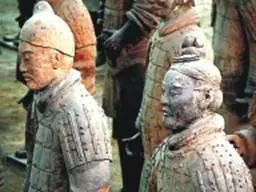
Some Background History
Qin Shi Huangfounded the Qin dynasty (221-206 BC) and united China. Although his rule was short and brutal, the grand projects which he embarked upon have ensured that his name will never be forgotten. Under Qin Shi Huang, the first version of the Great Wall was built and currency and writing were standardized, which alone put his name in the Chinese history books. It was common knowledge that the first emperor was interred near Lintong, but nothing was known of his guardian army until the 20th century. In 1974 a group of farmers were digging a wellwhen they unearthed a terracotta shard that appeared to be part of a statue. They duly reported their find and excavations were carried out, which revealed a pit of over a thousand terracotta soldiers. When they were first uncovered, many of the warriors still had remnants of their original painted coloring, but unfortunately the strong Shaanxi sun soon destroyed this. Further excavations uncovered another two pits and archeologists then began the painstaking process of putting the pieces together.
Legends & Facts
It is still unclear exactly why Qin Shi Huang ordered the construction of the Terracotta Warriors, but theories abound, among the most popular of which are that they were to guard his tomb in the afterworld, or that the soldiers were to protect him from the invading armies of the east. There are also rumored to be more pits to the north, west and south of Qin Shi Huang's tomb, but preliminary excavations have thus far revealed nothing of the sort. A similar range of tales circulate about the design of the warriors – some guides will tell you that the individual faces were modeled on real members of Qin Shi Huang's army, while others believe that the faces represent the workers who made them. What is more certain is the way they were made – kiln-baked in separate hollow sections (apart from the legs, which are solid) to avoid cracking and then put together and brightly painted. Some of the soldiers are over six-feet tall and there is yet more speculation about why they are so tall – some attribute their height to the belief that Qin Shi Huang would have only chosen the strongest soldiers for his imperial guard, while others feel that their stature was to intimidate spirits in the afterworld. The soldiers' clothing indicates their rank; some of them were originally clothed in leather armor and held metal weapons.
Visiting the Site
Hotels run tours to the warriors and nearby sites from around US$50, while hostels operate cheaper versions of the same from as little as $160 with a minimum of five people ($230 if there are only two of you, although this is unlikely in the summer as there is plenty of demand). The price includes round-trip transport, lunch and entrance fees. If you want to make your own way out to the warriors, a round-trip taxi should cost $150, including waiting time. If you take a tour, check how long you'll spend at the site (a minimum of two hours is recommended) and what time you'll arrive. It's definitely worth getting here early to avoid the crowds; if you're the first one here you'll get a blissful few minutes to savor the splendor before the hordes come. However you arrive, from the new car park it's a 10- to 15-minute walk to the site, or you can take an electric buggy for $15.
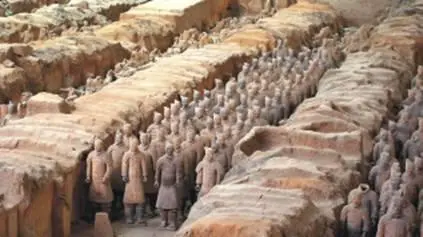
Pit One
On entering through the ticket gates, the first place to head is Pit Number One, which is straight ahead of you. In spite of subsequent excavations, Pit Number One remains the most impressive and on a sunny day the finely detailed faces of the soldiers catch the light through the opaque roof. Even from above you can clearly make out the differences in stature, clothing, headdress and facial expression. There are over a thousand figures here arranged in battle formation and you can walk around the edge of the enclosure to get a little closer to them. The lines of warriors are divided by earthen walls, which originally supported a wooden beamed roof. In the center there is a collection of terracotta horses, which originally had chariots behind them, and to the rear of the pit many of the figures lie shattered on the ground. In spite of signs forbidding photography, everybody takes photographs in this pit – just make sure not to use your flash.
Читать дальшеИнтервал:
Закладка:
Похожие книги на «CHINA's Three Gorges & Xi'an»
Представляем Вашему вниманию похожие книги на «CHINA's Three Gorges & Xi'an» списком для выбора. Мы отобрали схожую по названию и смыслу литературу в надежде предоставить читателям больше вариантов отыскать новые, интересные, ещё непрочитанные произведения.
Обсуждение, отзывы о книге «CHINA's Three Gorges & Xi'an» и просто собственные мнения читателей. Оставьте ваши комментарии, напишите, что Вы думаете о произведении, его смысле или главных героях. Укажите что конкретно понравилось, а что нет, и почему Вы так считаете.



